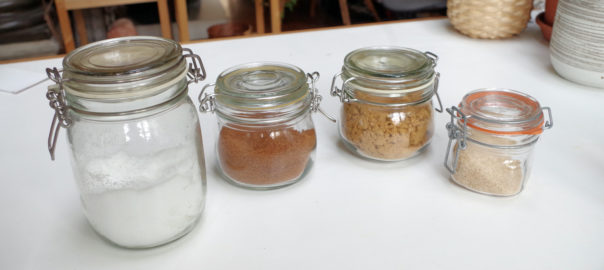The food industry has incorporated sugar in just about all common products, to the point of absurdity. Suppose you make a fresh tomato sauce with very fresh tomatoes, onions, garlic, fresh herbs. Would finish your sauce by adding two heaped tablespoons of white sugar?
Well, I guess not !
And yet that is exactly what the food industry does. Sugar is even added to things like bacon. All the bread in the supermarket has sugar in it.
The only reason why the food industry adds sugar everywhere, and even sometimes in hallucinatory amounts, is that sugar causes a physiological reaction that makes you want to eat even more.
As part of a 30-day no refined sugar challenge, I decided to take a look at how much sugar and in what form I actually keep in my pantry. Refined white sugar, the cocaine of sweeteners, has been out of my kitchen pantry for about 20 years. And when I bought or ate something sweet, like a piece of cake, I always went for the so-called better kinds of sweeteners. Like coconut blossom sugar, whole raw cane sugar and so on.
Glycemic index
One of the criteria for finding the best alternative was to go for the lowest “glycemic index” of a sweetener. That index is supposed to be a measurement of how fast sugar is metabolised, and the slower, the better. But it could be yet another false concept from the food industry. Each sweetener comes with its own marketing tactics, which would have us all believe that this one is better than the other. In Europe, cane sugar has long been considered better than the more common beet sugar. Simply because it is exotic and tropical and therefore has a more natural, unspoilt image. But it is still sugar.
Eight alternatives
Wow, I discovered that I currently have 8 alternatives to refined sugar in stock, some never used, some occasionally, albeit in moderate amounts. Today’s main sweetener for baking or making sweet desserts is not in the photos, that is medjoul dates. Apart from that, I still use a teaspoon of maple or rice syrup over a portion of soy yoghurt, for example.
It reflects a decades-long search for “the good/best sweetener”, but it also reflects the problem I really have: an excessive craving for sweet things. Even after a large, complete and healthy meal, I often feel the need to end it on a sweet note.
Resisting temptation
It must be purely emotional. Last night, for the first time in a long time, I felt an emotional dip, partly because I was physically and mentally very tired. Normally, I would smother such dips by grabbing a banana or an apple or putting a dried fig or date in my mouth. But this month I am playing the “no sugar” challenge: no more fruit during the day after breakfast. And also resist the temptation not only for refined sugar and its 60+ disguises, but for sweet in general. To see what this experience could teach me.
Sweet during childhood
I had been thinking all day about the role of sweetness today and in my childhood and youth.
Today, I am “tickled” to buy something sweet when I go into town. I eat sweet in search of peace, to escape stressful situations. When in town, I often walk into a health food shop or supermarket, even if I don’t have to be there. Just to get a supposedly healthy sweet date-nut protein bar and eat it to feel an instant sense of relief and satisfaction.
As a youngster, satisfying the sweet tooth was a daily ritual. Sugary things were everywhere. Bread with chocolate spread and jam was served at breakfast, together and mixed with salty cheeses or processed meats. No wonder I remember having stomach cramps every now and then. When we came home from school, around 5 p.m., my mother served us a sweet snack, made of sugared “Dr Oetker” pudding powder, to be dissolved in boiling milk. W either vanilla flavour or chocolate flavour. In the vanilla variant, my mother would always soak two or three speculoos biscuits (the typical Belgian allspice and cinnamon biscuit called speculoos). It tasted heavenly and kept us satisfied for a couple of hours before dinner, so that might have been some sort of device to control our behaviour.
Dealing with high sensitivity
I realise that, as a hypersensitive child I had to deal daily with rather mundane situations that were challenging and stressful for me. Plus there was a lack of my own territory. The sweet became like a drug. I must have rarely felt safe outside the house, and stressed once home. At home, there were the special events where we felt we were noticed or taken into account, with family dinners and their dessert buffets. Or the occasional waffle and pancake nights where you could cut through the sugar in the baking smells.
I am still very sensitive to auditory and visual over-stimulation, I dislike crowded, noisy environments or large crowds, and whenever I find myself in them, the craving for sweetness rears its head.
Recalibration
The really interesting part of the month will be the recalibration of the taste buds. By reducing my intake of concentrated sweetness, I can re-appreciate the subtle sweetness present in, for example, a cashew nut, in steamed pumpkin puree, in carrots, in a watermelon, in almond paste, in sprouted lentils or even in unsweetened grains such as boiled rice. I feel this will be a great benefit. Being able to taste the natural sweetness in pure, unprocessed foods without needing a shot or overdose of all those concentrated sweeteners.
It’s almost like learning to revalue life in its smallest aspects, without the need for powerful, explosive sensations.
What it will be about in any case is regaining freedom. Because if you find yourself craving a certain taste and getting saddled with an uncontrollable urge, you become a slave to it. To an emotion that doesn’t get a proper response. And which you try to numb with food.

